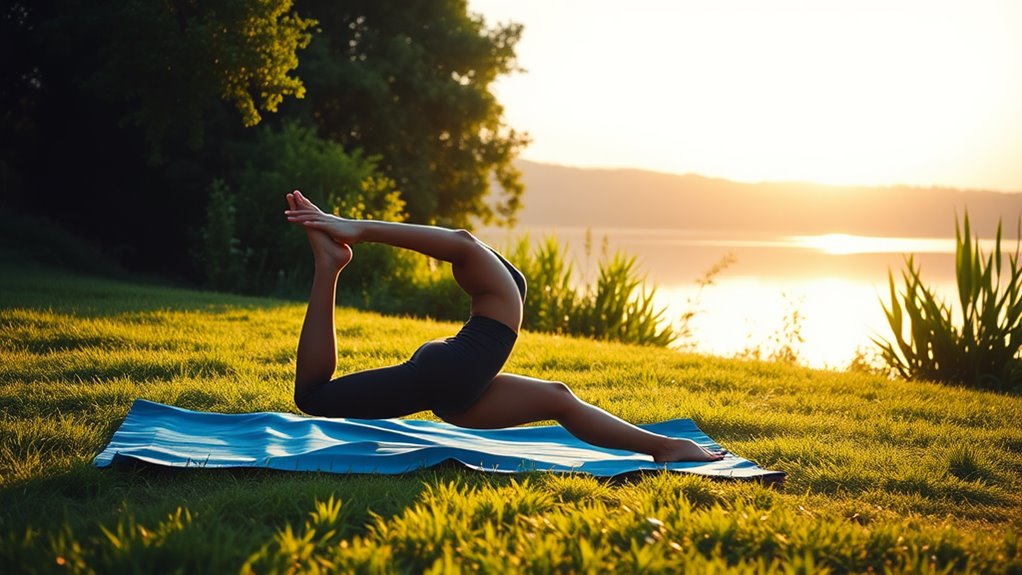Stretching Routines That Enhanced My Flexibility
Stretching routines can significantly enhance your flexibility, making daily activities easier and more enjoyable. Start your day with a morning stretching routine that targets major muscle groups. Incorporate dynamic stretches and focus on your breath to boost circulation and energy. Consistency is key, so dedicate a few minutes each morning to improve your range of motion. Celebrate every small gain, as it leads to lifelong benefits. Discover more about specific techniques and tips to stay on track!
The Importance of Flexibility in Daily Life
Have you ever considered how flexibility impacts your everyday activities? It’s not just about bending and reaching; being flexible enhances your overall well-being.
By incorporating morning health tips, like gentle stretches, you can improve your mobility and reduce the risk of injuries.
Flexibility allows you to perform daily tasks with ease, whether it’s picking up groceries or playing with your kids.
Plus, it boosts circulation, helping you feel more energized throughout the day. Effective morning stretching routines can also lead to lifelong benefits, making your body more resilient as you age.
Embracing flexibility isn’t just a physical endeavor; it’s a pathway to a healthier, more active lifestyle.
Morning Stretching Routine: A Step-by-Step Guide
Starting your day with a morning stretching routine can set a positive tone for the hours ahead.
You’ll not only boost your flexibility but also enhance your energy and focus. Incorporating these stretches into your morning can help reduce stress and prepare you mentally for the day ahead.
Let’s explore the essential stretches to include, and how long you should spend on each for maximum benefit.
Benefits of Morning Stretching
Why not embrace the morning with a few stretches to kickstart your day?
Morning stretching offers numerous benefits that can enhance your overall well-being.
It improves blood circulation, helping to energize your body and mind.
You’ll find that stretching increases flexibility, making daily activities feel easier and more enjoyable.
Additionally, it can reduce stress and tension, setting a positive tone for the day ahead.
By incorporating morning stretches into your routine, you’ll also promote better posture, which can alleviate discomfort throughout the day.
Essential Stretches to Include
Incorporating essential stretches into your morning routine can make a significant difference in how you feel throughout the day.
Start with a gentle neck stretch to release tension, then move to shoulder rolls to loosen up. Don’t forget a standing forward bend to stretch your hamstrings and lower back. Next, try a cat-cow stretch for spinal mobility, followed by a lunging hip flexor stretch to open your hips. Finally, finish with a seated figure-four stretch for your glutes.
These stretches not only enhance flexibility but also energize you, preparing your body and mind for a productive day ahead. Enjoy the stretch!
Timing and Duration Tips
How can you make the most of your morning stretching routine?
Start by dedicating just 10-15 minutes each morning.
This short duration can significantly enhance your flexibility and set a positive tone for the day.
Aim to stretch immediately after waking up, when your muscles are still warm from sleep.
Focus on holding each stretch for 15-30 seconds, breathing deeply to promote relaxation.
You’ll find that consistency is key—try to stretch daily for the best results.
Incorporate a variety of stretches targeting different muscle groups to ensure a balanced routine.
You’ll feel more energized and ready to tackle anything that comes your way!
Targeting Major Muscle Groups
Targeting major muscle groups is crucial for enhancing flexibility and overall movement efficiency.
Focus on areas like your hamstrings, quadriceps, hip flexors, and shoulders.
Incorporate stretches like the standing quadriceps stretch, seated forward bend, and shoulder cross-body stretch to effectively loosen these muscles.
When you consistently engage these key areas, you’ll notice improved range of motion and reduced risk of injury.
Remember, it’s about quality over quantity—hold each stretch for at least 20 seconds, breathing deeply.
Commit to this routine, and you’ll not only feel more flexible but also more confident in your body’s capabilities.
Keep pushing forward!
Incorporating Dynamic Stretches
Incorporating dynamic stretches into your routine can significantly enhance your flexibility and overall performance.
These movements not only warm up your muscles but also prepare your body for the activities ahead.
Let’s explore some effective dynamic stretch examples that you can easily integrate into your workout!
Benefits of Dynamic Stretching
Dynamic stretching offers a powerful way to enhance your flexibility and prepare your body for physical activity.
By incorporating these movements into your routine, you’ll increase blood flow to your muscles, which helps reduce the risk of injury. You’ll also boost your range of motion, allowing for better performance in your workouts and daily activities.
Plus, dynamic stretches activate your nervous system, improving coordination and balance.
Engaging in this type of stretching can elevate your energy levels and enhance mental focus, setting a positive tone for your exercise session.
Effective Dynamic Stretch Examples
To truly reap the benefits of dynamic stretching, it’s important to incorporate specific movements that effectively warm up your body.
Start with leg swings, moving your legs forward and backward to loosen those hip joints. Next, try arm circles—small to large—to prepare your shoulders. High knees and butt kicks are fantastic for activating your lower body while increasing your heart rate. Don’t forget walking lunges with a twist, which engage your core and improve flexibility.
These dynamic stretches not only enhance your range of motion but also prepare you mentally for your workout. Get moving and feel the difference!
The Role of Breath in Stretching
Breath serves as a powerful tool in enhancing your stretching routine.
When you inhale deeply, you oxygenate your muscles, preparing them for deeper stretches.
Exhaling allows you to release tension, making it easier to sink into poses.
Focus on your breath; it can guide you, helping you find your edge without forcing your body.
As you stretch, synchronize your movements with your breathing, letting each exhale carry away stress and tightness.
This mindful approach not only improves flexibility but also cultivates a sense of calm. Additionally, incorporating effective breathing techniques into your routine can significantly reduce stress levels, ultimately benefiting your overall flexibility and well-being.
Tips for Staying Consistent
Here are some tips to help you stay on track:
- Set a specific time each day for stretching.
- Use reminders on your phone or calendar.
- Pair stretching with another daily habit, like brushing your teeth.
- Create a dedicated space for your stretching routine.
- Start with short sessions and gradually increase the duration.
Incorporating stretching into your routine can significantly enhance your sleep quality, which ultimately helps with morning vitality.
Tracking Your Progress and Results
Staying consistent with your stretching routine is only part of the journey; tracking your progress can elevate your flexibility game even further.
Keep a stretching journal to note your routines, duration, and feelings after each session.
Take weekly photos to visually assess your improvements and celebrate small victories.
Use apps or fitness trackers to log your sessions and set attainable goals.
These methods not only boost motivation but also help you pinpoint areas needing extra attention.
Remember, progress isn’t always linear, so embrace the journey.
Celebrate every inch you gain; it’s all a step toward becoming more flexible and in tune with your body. Incorporating regular assessments like photos can reflect changes in hair health and encourage continued commitment to your flexibility training.





